Mike Bartick: Reflection Tubes
Macro trends come and go pretty quickly these days with all kinds of gimmicks and different methods of attempting to apply new and creative twists to image making. Never has the phrase “everything but the kitchen sink” been more applicable though when it comes to the reflection tube, or “the drainpipe of creativity” as it has been named!
Don’t get me wrong, I love trying new things and am always looking to try something different. I also think having multiple layers in a portfolio is essential and it is fun to try new stuff, either by planning a particular shot or by testing out the latest gizmo found at the trade shows.
I’ve learned that reflection tubes are not a new idea and that many shooters were using these things years ago for all kinds of different photography. I fashioned my tube after seeing my friend’s design but in a more straightforward way.
• Straight chrome pipe from home depot:-$6.00USD • Rubber Flange:-$4.00USD • Zip Tie: $.25USD • 2 Large coffees from Starbucks cost almost as much as building this silly tool with nearly the same dizzying effect. • Saga tube-125.00 • Magic Light tube 125.00 Euro
The idea is to build a tube that is long enough for your lenses working distance yet narrow enough to create an interesting design. The reflection occurs naturally when aimed at your subject then accentuated when the flash is triggered.
Fortunately, you can now purchase the reflection tubes online. Coming in a variety of lengths and apertures to allow you to shoot with a 60mm/100mm or 105mm, full frame, APS-C even compact cameras and diopters can be used.
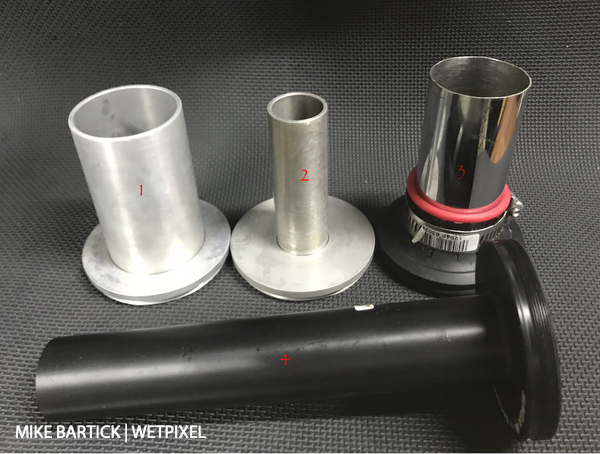
- (and 2) Pre-made “Light tubes.” Both come as a set and allow you to shoot with almost any macro lens or kit lens in your bag. They offer a nice reflective quality and pack well.
- This is my DIY project; it’s very basic but effective. Crafted from a standard drainpipe found in the plumbing aisle. I also picked up the rubber flange, and after a few minutes, I was on my way.
- Is another readily available device from Saga. Is a bit longer, so I use this one with my longer macro lens for fish portraits.
I’ve even had a friend use PVC pipe in various colors with some decent results; the point is to use something that is reflective.
The store-bought devices in this image have a 67mm threaded base so that they can be attached to a standard flip adapter as opposed to mine which I hand held against my lens port. As with any image, lighting is everything and how you apply the light to your image will set it apart from the others. When your shooting this style of image, you will quickly notice that you can get multiple different effects by changing the lighting angle.
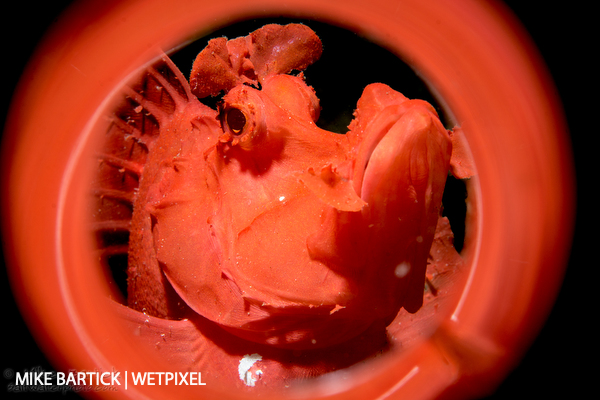
I made this tube about 4 years ago and used it a few times with my 60mm lens. I discovered nearness to the subject with the tube can give it the appearance that the subject is nearly in-side of the tube itself.
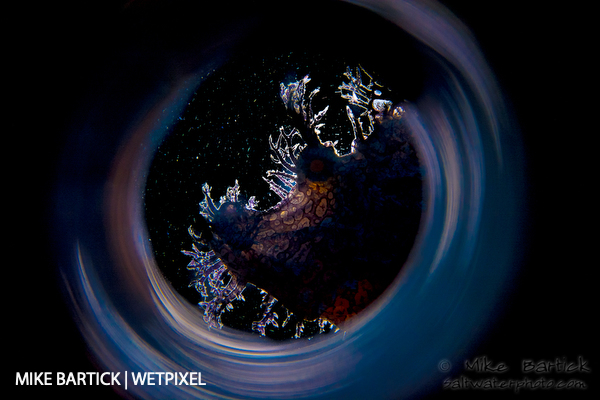
Blue UV backlight and sand sprinkles for effect
After lining up on this purple Rhinopias and shooting a few times, I decided to try something different. Using the blue mode on my torch for backlighting, and taking advantage or the particulate in the water, I was able to capture a photo that I thought was pretty interesting. For me, it looks like the rhinopias is in space!
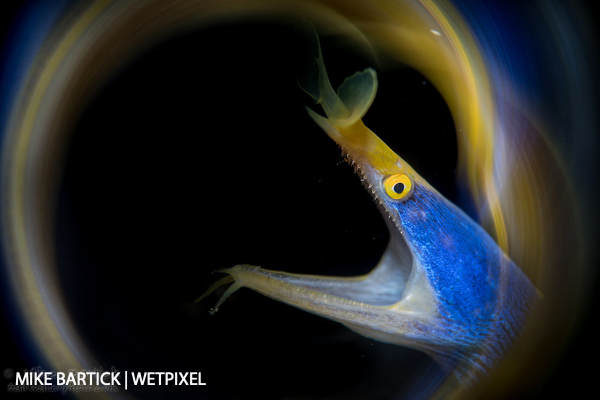
Blue Ribbon Eel
Creating something exotic from something as familiar as a blue ribbon eel can pose all kinds of challenges. I used my snoot to help eliminate the sand and rocks behind the subject then remained patient and waited for the eel to move into the right position. When my strobe flash hit the subject the first time, I was hooked. The cobalt blue and gold came through nicely in the tube.
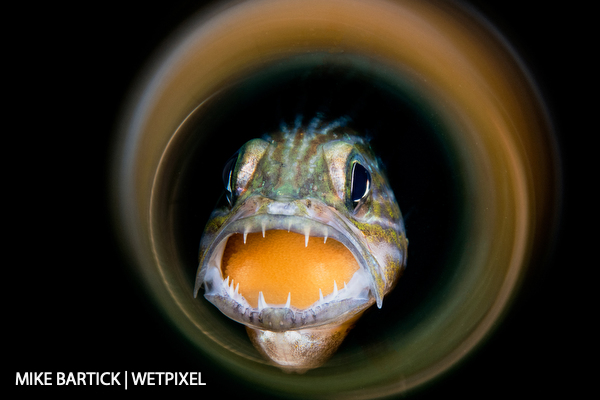
Taking the show on the road to capture some animal behavior I selected the cardinal fish with eggs to start. Waiting is the name of the game with shooting behavior and capturing this image was no different. The cardinal fish actually seemed curious about the tube and came very close to look inside.
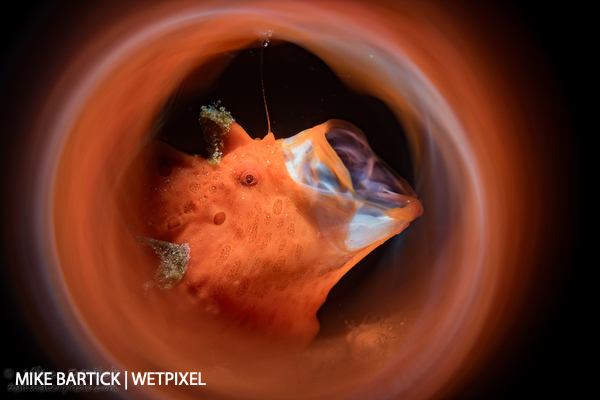
I’ve attempted to shoot a few different varieties of frogfish with the reflection tubes, and oddly enough, none of them seemed to move me. When it came to yawning, I liked the side profile image better than the head on ones I had shot previously. This composition seems to catch the energy and movement of the frogfish more than the other photos.
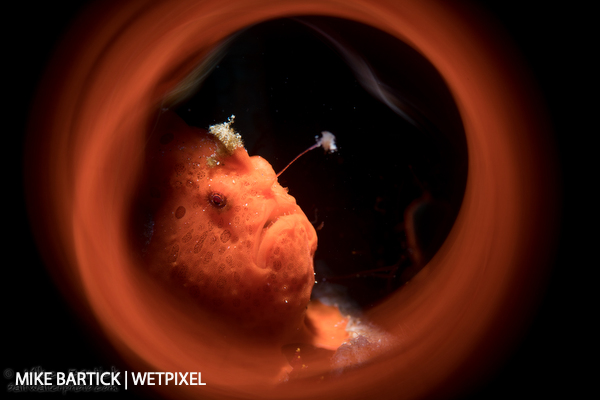
The fishing behavior of the same frogfish moments before it yawned. Whites, seem to create a nice creamy addition to the images. The quality of the swirl, ease of use and overall results should guide your decision when selecting one of these types of devices, either to pur-chase or to make.

A ubiquitous photo with a twist. I probably wouldn’t submit this to win a contest but an interesting subject to practice on. Using a diopter is also possible as long as the length of the tube does not exceed the working distance of the wet lens/diopter your using.
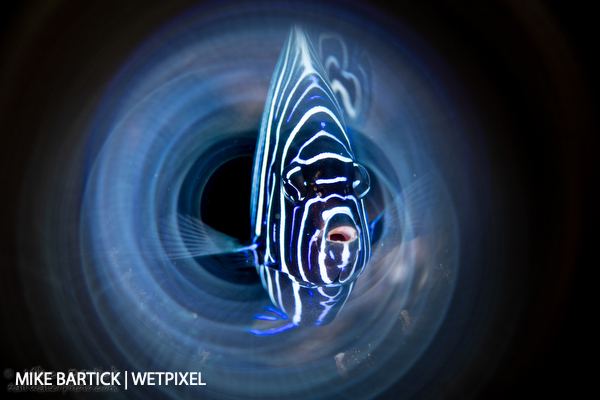
The ultimate for fish photography, which is hard enough to start. The saga reflection tube is by far the longest of the 3 styles of tubes that I used for this article. The interior of the tube has a second, clear tube that enables the shooter to create different designs in their reflection, almost like a kaleidoscope. However, by overextending the clear tube, it can also create a ring within the image itself, be careful.
The quality of the swirl should be thought of along the same lines as the quality of your bokeh. Is it rough or smooth, are the transitions from the actual subject to the reflection smooth, are you getting the reflection that you desire? Lighting and reflective colors will significantly affect and impact your images through the amount of reflection the tube picks up. Experiment and try to photograph multiple subjects in various scenarios for the best results.

The color of the eel caught my eye first, that and the fact that there were 6 of them living in the same little tire. After a minute of watching I discovered the reason why the eels were all there to being cleaned.
I’m not overly convinced that by using a reflection tube qualifies as being creative, but they are indeed fun to play with. They can help to create some interesting images for sure but beware mediocrity is still the challenge. Expanding your portfolio is, and trying new things will always lead to a path of creativity, learning and the ultimate photo op.
Have fun!
About the Author
Mike Bartick of Saltwater Photo is a professional underwater photographer who is widely published and also manages the Crystal Blue Dive Resort in Anilao, Philippines.